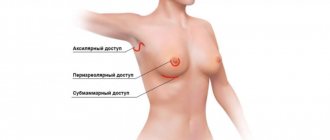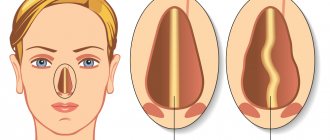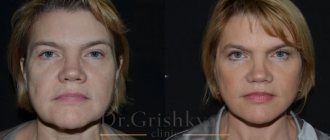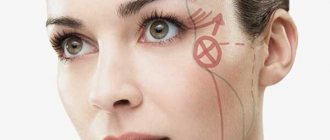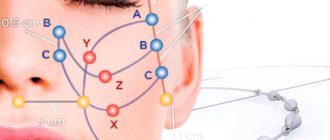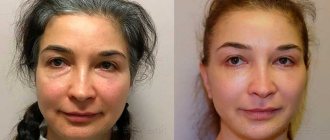A circular facelift (facelift) is a complex but popular anti-aging operation, especially among patients over 40 years of age. There are no alternatives to SMAS lifting - during this plastic surgery, the surgeon works not only with the skin, but also with the superficial muscle-fibrous layer. During the facelift, a clearly defined and tightened oval of the face is modeled, and excess skin that has stretched and lost its tone is removed. A facelift can make you look 10-15 years
, get rid of wrinkles, jowls and other pronounced signs of aging. The result of a facelift, unlike, for example, thread lifting (mesothreads), lasts for many years - from 10 years or more, and with careful and careful post-operative skin care - more than 15 years. Patients often believe that the results of a facelift will be visible immediately, but this is a misconception. Rehabilitation after a facelift may take several months, depending on the individual characteristics of tissue restoration. In this article we will talk about the progress of recovery after a facelift, share the recommendations of our plastic surgeons and the secrets of express recovery from cosmetologists.
How is recovery after a facelift?
Recovery time after facelift
Plastic surgeons at the Pirogov Clinic are fluent in minimally invasive facial rejuvenation techniques (for example, endoscopic lifting can also be done in our clinic). Hospitalization
after deep SMAS face lifting is 1 day.
Before being discharged from the clinic, the patient is put on a special fixing bandage
that covers the neck and scalp.
It should be worn for 3-4 days. The sutures
are removed during a follow-up examination by a plastic surgeon after 10-12 days.
Pain after a facelift is not very pronounced, and, if necessary, can be relieved with painkillers recommended by a doctor. Most often, patients describe their sensations as “discomfort due to skin tightness,” “tingling,” “numbness.”
On our website you can find
reviews about facelifts, in which our patients share their experience of the operation and talk about their feelings.
Bruises disappear within 2 weeks, and swelling subsides within several months - depending on the individual characteristics of the body.
The patient can return to work 2-3 weeks after the facelift; before this, it is better to recover in a calm environment. The early results of the operation can be assessed after 1-2 months, when the swelling decreases.
Once this early rehabilitation period is completed, most strict restrictions are also lifted.
It is important to follow your doctor's recommendations and undergo follow-up examinations. Recommendations for recovery after facial plastic surgery are extremely individual - below we provide only a general list of recommendations for recovery after a facelift.
Endoscopic facelift
It is a minimally invasive surgical technique. It is performed using a probe with a video camera and special instruments through small incisions (up to 2 cm) in the scalp and oral cavity.
The use of special equipment allows the surgeon to obtain a magnified image of the tissue. Maintaining blood flow in the skin and tissues significantly reduces the severity of swelling and negates the likelihood of baldness.
Ideal candidates for endoscopic repair are:
- Young patients (from 30 to 40 years old) with the first stage of aging and pronounced changes in the upper and middle zone of the face (most often caused by genetics)
- Men
- Patients requiring re-lifting of the upper and mid-face area
- Patients with deep horizontal and glabellar wrinkles in the forehead area
- Patients with drooping or drooping eyebrows
Endoscopic lifting is performed under general anesthesia or local anesthesia in combination with intravenous sedation. Its duration is 2.5 - 3 hours.
The stitches are removed after 8-10 days. The rehabilitation period is 9 - 14 days. Endoscopic plastic surgery leaves virtually no scars.
At the same time, the procedure allows you to smooth out vertical and horizontal wrinkles in the forehead and eyebrow folds, eliminate crow’s feet and bags under the eyes, lift drooping eyebrows, and even out the contour and oval of the face.]
Endoscopic facelift can be combined with blepharoplasty, lipofilling, and neck lift. This is an ideal choice for young patients with problems in the upper and middle third of the face without significant excess skin, which makes it possible to do without incisional surgery. This technique is not inferior in results to open facial plastic surgery and allows you to achieve excellent and harmonious rejuvenation.
Recommendations from a plastic surgeon
- For 2-3 weeks after the facelift, we recommend recovery and rest in a calm environment - it is better to take a vacation from work during this period.
- From the first day after surgery, the patient is prescribed a course of antibiotic therapy to reduce the likelihood of infectious complications after a facelift.
- Proper nutrition (protein foods, antioxidants, “right” fats, fresh vegetables and fruits), adherence to a drinking regime and good sleep will also help you undergo rehabilitation easier and faster. If after a facelift it is difficult to open your mouth and chew food, it should be finely ground on a grater or in a blender.
- We recommend patients a recovery course after a facelift, which includes microcurrent and electrostatic lymphatic drainage massage, and sometimes ultraphonophoresis. These procedures improve blood microcirculation, remove excess fluid (ensure lymph outflow), that is, they quickly relieve swelling and promote rapid tissue regeneration. A course of cosmetic procedures reduces the recovery time after SMAS facelift by up to 2 times.
Read more about the course of recovery procedures after plastic surgery
Temporal lift
Designed to eliminate age-related changes in the upper facial area. Helps lift the outer corners of the eyebrows, smooth out wrinkles in the corners of the eyes, slightly lift the upper eyelids, fatty tissue in the cheekbones and sagging cheek tissues. During a temple lift, small incisions are made in the temporal part of the scalp. More information about frontal-temporal lifting can be found here
What not to do after a facelift
- Before and after facelift surgery, you should not take medications that affect blood clotting (for example, acetylsalicylic acid).
- Refrain from intense physical activity and going to the gym for 1 month.
- It is not advisable to drive a car in the first week after the facelift.
- The first time after facial plastic surgery, you cannot do a facial massage on your own - if you really want to, it is better to undergo a lymphatic drainage massage procedure in the office of a cosmetologist.
- Refrain from going to the sea for 1 month. Intense ultraviolet radiation and tanning should be feared even longer.
- You can visit the sauna after a circular facelift no earlier than 1 month later.
- During the course of antibacterial therapy after a facelift, you should not drink alcohol; it is also better to refrain from smoking so that the skin restoration process proceeds quickly, efficiently and without complications.
- Lightening and dyeing hair - exposure to household chemicals should be avoided at least during the first month after the intervention.
- Decorative cosmetics can only be used 1-2 weeks after a facelift.
A facelift is not an easy aesthetic operation, but a healthy lifestyle and adherence to these and other recommendations from your doctor ultimately determine the success of the beauty procedure. Plastic surgeons at the Pirogov Clinic are always in touch with their patients and guide them until the successful completion of the recovery period. The cost of a facelift operation in our clinic already includes postoperative observation by a surgeon: dressings, suture removal, consultations.
Non-surgical methods
If you've been reading my blog for a long time, I'm unlikely to reveal anything new to you. I have already addressed the topic of non-surgical methods of facial correction in previous articles.
We talked about them in a review article on types of facelifts. And in narrow articles on point corrections.
Therefore, I will not dwell on them in detail. Let me just remind you of the main types:
- Thread lift
- Contour plastic
- Volumetric modeling
- Biorevitalization
- Bioreinforcement
- Plasmolifting
- Mesotherapy
- Hardware lifting
- Ultrasonic
- Cryolifting
- RF lifting
- Fractional photomermolysis
As you can see, there are many methods. But they all have common disadvantages: a short-lived effect and loss of effectiveness.
I will be happy to tell you about each of them in more detail if you are interested. But today I want to devote more time to surgical methods.
Firstly, because I am a plastic surgeon and such techniques are my specialty.
Secondly, because in the end many people come to a surgical lift. This is due to the fact that after a certain age, non-surgical methods become useless. The effect from previous procedures disappeared, and from new ones did not even appear.
Skin care after surgery
Careful post-operative facial skin care will help you recover faster after a facelift and consolidate the results of rejuvenation for many years.
Electrostatic and lymphatic drainage facial massage
The first procedure can be done already 3-4 days after the facelift. The essence of the technique is to manually or mechanically influence the skin in the direction of lymphatic drainage. Electrostatic lymphatic drainage massage allows you to quickly remove swelling after surgery, improves blood microcirculation and thus promotes tissue regeneration.
In addition, lymphatic drainage massage has other positive effects:
- Skin lifting;
- Fights wrinkles;
- Models facial contours;
- Improves skin tone.
Our patients also note that lymphatic drainage massage reduces discomfort and makes recovery after a facelift easier.
Skin care with professional cosmetics
Professional cosmetics from Cellcosmet, Academie, Maria Galland include special active ingredients, which were developed by the best beauty laboratories in Europe. Thanks to this, such care is highly effective and makes the result of a facelift lasting. Depending on the initial condition of the skin and its type, the cosmetologist-esthetician selects the appropriate option:
- Regenerating agents;
- Premium moisturizing creams;
- Serums and creams for sensitive skin (for example, Fulfillment);
- Products with a rejuvenating lifting effect;
- Lymphatic drainage serums to relieve swelling.
Injection cosmetology
The first time after a facelift, such procedures should not be performed so as not to injure the skin. However, in the future, injection cosmetology can prolong youth and solve a wide range of problems to improve skin quality at the cellular level.
- PRP therapy - platelet-rich plasma stimulates the synthesis of your own collagen and elastin fibers. The procedure will help maintain skin tone and turgor, neutralize the effect of gravitational ptosis on the oval of the face, and protect against wrinkles, pigmentation and other skin defects. Plasmolifting goes well with nanolipofilling. The procedure can be done as early as 3-4 weeks after the facelift.
- Mesotherapy, biorevitalization, injections of vitamin cocktails - after facial plastic surgery (this is still stress for the skin) ensure restoration, nutrition and hydration. The procedures can be done 1-2 months after the facelift. Preparations with nonlinear hyaluronic acid and amino acids have an extremely beneficial effect. Such procedures promote rapid and high-quality healing of scars.
Additional beauty care procedures after a facelift are, of course, not mandatory. The main principle is to take care of your beautiful face and pay attention to your own health. Without this, even additional cosmetic care may not be as effective. Our main goal is to prolong your youth, joy and pleasure from the result of aesthetic surgery.
MACS - lifting
A surgical facelift aimed at eliminating sagging in the middle and lower part of the face. Suitable for patients aged 40 to 55 years who want to correct the oval of the face, eliminate jowls, smooth out nasolabial folds, and increase the tone of the tissues of the chin and cervical areas. This technique is especially effective in young patients. MACS is a modified S-lift technique and is limited to a minimal scar in front of the auricle. During the operation, a small amount of excess skin is removed and the sagging tissue is fixed in a vertical direction using two or three purse-string sutures. By applying two purse-string sutures, ptosis of the cervical region and cheeks is eliminated. The third purse-string suture improves the zygomatic area, the area of the lower eyelid, the nasolabial fold and the middle area of the face. The duration of the operation is 2.5 hours.
The rehabilitation period is 2 - 3 weeks.
Most patients return to work within 10 days.
Allows you to maintain a natural look thanks to the vertical tension of the skin versus the traditional lateral one.
A small area of skin detachment allows you to maintain nutrition and blood supply to the tissues, which reduces the risk of difficult-to-resolve swelling and hematomas, which is extremely important for smoking patients.
MACS lifting will not lead to the removal of bags under the eyes, wrinkles in the eye and forehead area, therefore, to obtain comprehensive rejuvenation, it is recommended to combine MACS with blepharoplasty, forehead and eyebrow plastic surgery.




